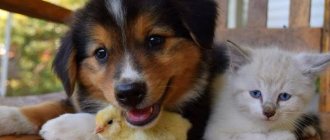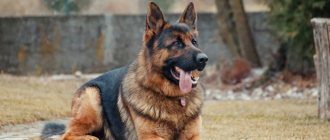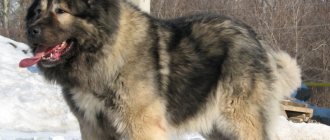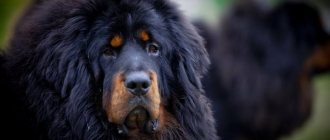Decorative dogs are popular due to their attractiveness, miniature size, and ease of care. The Tibetan Spaniel is one such pet. The breed has an interesting history of origin and is considered a temple and noble breed. The funny appearance touches many lovers of four-legged animals. If properly raised, the Tibetan Spaniel will become an obedient, loyal friend.
Breed characteristics
| Short description | |
| Origin: | Tibet |
| Conditions of detention: | Apartment, house (room) |
| Purpose: | Companion dog, decorative dog |
| Color: | Any |
| Wool length: | Long |
| Adult dog size: | Height – 23-25 cm, weight – 4-7 kg |
| Average life expectancy: | 13-15 years old |
| Walk: | Need two walks a day |
| Physical activity needs: | Average physical activity needs (20-30 minute walks) |
| Fédération Cynologique Internationale (FIC) classification: | Group 9: decorative and companion dogs; section 5: Tibetan breeds |
| Puppy price: | 20000-45000 rubles. Pet class – 20,000-25,000 rubles, breed class – up to 40,000 rubles, show class – 45,000 rubles |
Diseases and life expectancy
The average life expectancy of a Tibetan spaniel is 16-18 years. This high rate is achieved due to a good level of general health. Tibbies rarely get sick, especially if the owners adhere to the rules of keeping them. The most common possible diseases are:
- ear diseases;
- conjunctivitis, cataracts, glaucoma;
- problems with the spine;
- allergic reactions.
It is recommended to have a preventative examination with a veterinarian annually to avoid possible diseases.
History of the origin of the species
The symbol of Buddhism is the lion, statues of which decorated all the temples of Tibet. The dog, named Tibby, reflected both the appearance and character of this formidable cat. Monks placed dogs on the walls of their cells and monasteries . When Spaniels spotted a threat, an unexpected guest, or a horde of enemies, they barked loudly, telling their companions, the Tibetan Mastiffs, that it was time to defend the home.
It is unknown when the breed appeared. There are two versions: the animals existed for a long time and became the progenitors of many dogs, or the dogs are the result of mixing the blood of Shih Tzu and European spaniels. One way or another, Tibbies were not sold and existed closed in Tibet.
Puppies were only allowed as gifts. They ended up in China, Japan, and other Buddhist countries, where they mixed with aboriginal dogs and gave birth to the Pekingese and Japanese Chin. European countries learned about the exotic pet in 1880 thanks to the breeder Mac Laren Morrison.
The breed gained popularity among the European nobility only in 1920 , but after the war, almost all individuals in England and Germany were exterminated. In 1947 , work began to restore Tibby, and by 1960 they were recognized by the English Kennel Club.
Character of the Tibetan Spaniel
Spaniels are considered hunting dogs, but this is not the case with Tibbies. He has always been recognized as a companion dog. The Tibetan Spaniel has a very kind disposition, he is cheerful, playful, respects his owner, but also demands respect for himself. The breed is very active and loves walks in the fresh air.
Since since ancient times the tibby has guarded the peace of monks at a decent height, even in our time its descendants are not averse to jumping onto the back of a sofa or wardrobe. In this, Tibby is related to a cat. You can also compare them based on their ability to relieve stress, since spaniels are very sensitive to changes in the owner’s mood. They have a hard time with scandals and quarrels in the family.
Tibbies behave loyally towards other pets. But they treat strangers with suspicion, although they do not show aggression. This breed is not prone to hostility at all and gets along easily with other individuals. There is a good relationship with children, but the dog will be indignant if they start dragging it by the tail and ears. Therefore, it is worth monitoring the child’s communication with the animal. The spaniel gets along best with children over the age of seven.
The Tibetan Spaniel loves walks in the fresh air, and his playful mood will rub off on his owner.
One of the signs says that tibby is a talisman that protects against evil spirits.
Video: Tibetan spaniels playing while walking
Distinctive features
This is a small dog with strong, squat bones and a flattened muzzle. Tibbies can be called short-legged, with a height of 23-25 cm, they do not even give half the value. The body format is elongated. Average weight – 4-7 kg.
- The head is not large, but wide between the ears. The skull is flat, with a prominent forehead and a smoothed occipital region.
- The muzzle is flattened, raised, noticeably shorter than the skull. The bite is of the “overshot” type, but the shift is insignificant. The lips are pressed tightly to the gums.
- The nose is large and black.
- The eyes are set at stop level, round, not protruding. The iris is dark.
- The ears hang down on hard cartilage. Planted high and wide, medium-sized, surrounded by wool.
- The body is elongated, rectangular in format, muscular. The top line is straight, with a slightly raised loin and withers. The croup is rounded. The chest is wide, but not deep. The neck is long and thick.
- The tail is set high, rises above the croup and is wrapped in a ring.
- Limbs are short, straight, parallel. The paws are small and elongated. Gait: hobbling, springy movements.
- The coat is soft, silky, straight. The undercoat is short. Length – average. Elongated feathering on the ears, tail, and back of the limbs.
- Colors: from light to dark; black dogs with white markings on the forehead are favored.
Color variations
The official breed standard allows any coat color of Tibetan spaniels. Most often there are individuals with fur of black, golden, red and all shades of brown.
Both the presence of transitions and play of tones, as well as solid colors, are acceptable, but there are practically no such dogs; more often there is a combination of three or more colors.
Particularly valuable are individuals with dark fur and a white spot on the chest, which, as Tibetan monks believed, is a symbol of a pure heart.
A white spot located on the forehead is considered a sign of the Buddha's favor, and a white tail indicates the dog's thieving tendencies.
Photo of an adult dog
Interesting Facts
The history of the appearance of the Tibetan spaniel goes back more than twenty centuries and is replete with interesting facts:
- The first written mentions of similar dogs appeared in the 8th century AD.
- Before the breed was brought to Europe, puppies were only allowed as a gift as a sign of gratitude.
- In the temples of Tibet, tobbies, in addition to guarding, had the honorable duty of rotating prayer wheels with special inscriptions. It was believed that this would help attract good spirits.
- Because of the term "spaniel", many people think of tobbies as hunting dogs, but they have nothing to do with them.
Photos of puppies
Vaccinations and susceptibility to disease
The Tibetan Spaniel is a dog with average health. To reduce the likelihood of developing serious infectious diseases, your pet is vaccinated in a timely manner.
Be sure to get vaccinated against:
- carnivore plague;
- parainfluenza;
- enteritis;
- hepatitis A.
Vaccination against these diseases is carried out at 2.5 months and repeated at 12. Then repeated vaccinations are carried out annually. At 7 months (after changing teeth) a rabies vaccination is given.
With improper maintenance and unbalanced nutrition, the risk of developing various diseases increases. First of all, the Tibetan spaniel is susceptible to allergies and joint pathologies.
Other common ailments include:
- shortness of breath, breathing problems;
- dysfunction of the cardiovascular system;
- diseases of the eyes and ears.
ATTENTION! For timely detection of deviations from the norm, the pet is taken to the veterinarian for examination every 4–6 months.
Features of character and behavior
These dogs are no longer capable of guarding throne rooms like dozens of centuries ago, but they cope well with the role of an apartment dog and a pet. They idolize their owners, adore members of the household, but are wary of strangers. Spaniels are peaceful and calm, they do not have excess energy, but dogs will be happy to play with children.
But animals are narcissistic, they will not allow themselves to be limited, they will not tolerate bullying. They are characterized by imperial pride and monastic restraint. To achieve mutual understanding and psychological balance, you need to devote maximum of your time to your pet.
Advantages
Owners note a lot of positive qualities of the breed:
- Playfulness, affection;
- Unobtrusiveness, self-sufficiency;
- Good guard qualities, loud voice (no habit of barking for no reason);
- Love for children and other pets;
- Devotion to the owners, selfless love;
- Courage;
- Development of mind, ability to learn;
- Lack of aggression, balance, restraint.
Flaws
It is possible to identify specific shortcomings only in a certain individual, knowing the quality of its upbringing, the characteristics of its maintenance, and its psychological state. In the case of the Tibetan Spaniel, minor disadvantages are offset by advantages:
- Narcissism, need for free space;
- Self-confidence, disobedience;
- Stubbornness, lack of awareness of one's small size;
- Constant need for attention from owners and surrounding people.
Training and education
The description of the Tibetan Spaniel breed specifically states that these dogs are stubborn and difficult to train. But Tibby breeders to some extent refute this statement. Dog owners claim that their pets are very smart, quick-witted, and understand perfectly well what is required of them. The problem is that representatives of the breed are stubborn and prone to making independent decisions. If a command contradicts their inner beliefs, the dogs will not carry it out.
To achieve success, you need to start raising a pet as early as possible. A smart Tibby puppy will easily master basic commands and rules of behavior in an apartment or on a walk. It will be very difficult to cope with an adult.
Classes should be structured so that they are interesting to the dog. Rigid training is not accepted by these royalty. You need to act only with the help of praise and encouragement, earning the respect of your pet. This breed will only carry out tasks from the person it recognizes as the leader. A positive assessment from the owner is very important for a Tibby; he will try to earn it again by any means necessary.
Since dogs have a strong protective instinct, they need to be accustomed to the company of other people and dogs from a very early age. This way they will learn not to perceive everyone around them as enemies, and will perceive them kindly.
Care and maintenance
Such a dog can only be kept indoors, both in a house and in an apartment. Tibby is not large and easily lives in small city apartments. But for harmonious development, he needs his own place and a little personal space. Therefore, it is better to think in advance where to organize a place for the puppy so that he can hide from prying eyes.
Purchase a cozy indoor lounger or house, bowls on stands for height adjustment, combs, toys. The breed is not difficult to maintain, but regular walking, veterinary care and quality nutrition are the key to healthy development.
Nutrition
The problem of the breed is allergic reactions to food, so the diet for representatives is prepared especially carefully. The menu can be made up of dry food or natural food.
The first option is suitable for owners who do not have time for frequent cooking and have the finances to purchase a high-quality product.
Dry food is classified according to a special system: economy, super, super-premium, holistic, human grade (fit for human consumption). Tibetans need a super-premium or holistic class for dogs with allergies. If there is information about the exact products that cause the disorder, then the composition can be subtracted.
Natural feeding is cheaper, but will require time spent selecting ingredients for the menu and preparing them. It does not contain all the necessary minerals, so vitamin supplements will be required.
The daily diet consists of 2/3 proteins (meat, eggs, sea fish, dairy products). Tibetan Spaniels need rabbit, lamb, and turkey. The rest of the serving is grains and fats (rice, buckwheat, oatmeal, vegetable oils). Cereals are boiled in water without salt or seasonings. It is recommended to accustom your pet to vegetables and fruits.
Human food is prohibited: fatty, fried, salty, sweet, flour. The list of harmful foods includes: pasta, bread, potatoes, pork, butter, sugar, chocolate, citrus fruits, legumes, bones, cabbage.
An adult dog is given food 2 times a day, 300-400 g each. The volume depends on weight, activity and time of year (less is needed in summer). If the pet does not finish eating, then the portion is reduced, and if it requires more, then it is increased. Puppies 3-5 months old are fed 4 times , 6-8 months old - 3 times . Then they are transferred to standard nutrition.
Bowls are washed after each meal. The drinking bowl is always filled with clean water.
We recommend that you read a detailed article on the topic: “How and what to feed a dog: types and characteristics of nutrition.”
Health
The breed's gene pool is small, and therefore its health is fragile, but with proper care, regular vaccinations and veterinary examinations, Tibbies live up to 12-15 years. What needs to worry is those owners who bought a puppy from a private person and do not have information about the baby’s parents.
Vaccinations
There are mandatory vaccinations and those recommended during peak incidence. Mandatory vaccinations include:
- enteritis;
- parainfluenza;
- carnivore plague;
- hepatitis A;
- leptospirosis.
The vaccine is administered at 2, 2.5 , 6 months, repeated at 12 and annually ). Mandatory rabies vaccination is done at 7 months , after changing teeth, and annually . Without these injections, the dog is considered dangerous to people and cannot be transported across the border.
Additional vaccinations (mycoplasmosis, lichen) are carried out by veterinary clinics in conditions of increased infection in the city or region.
Each owner draws up a vaccination schedule, based on the recommendations of the breeder or veterinarian, and receives a veterinary passport after the first procedure. All injections and bottle labels are placed there.
2 weeks before vaccination, the pet is cleaned of internal parasites. On the day of the procedure, the temperature is measured to check health, only healthy animals are vaccinated. All injections are carried out under sterile conditions by specialists or experienced dog breeders.
After vaccination, you may experience lethargy, lack of appetite, soreness at the injection site and a small bump. If symptoms last longer than 3 days, you should contact your veterinarian. An allergic reaction manifests itself immediately (salivation, convulsions, rashes), in which case you should contact a specialist immediately.
Important article on the topic: “Everything you need to know about dog vaccinations.”
Diseases
The most common problem of Tibetan Spaniels is food allergic dermatitis and other irritations: gastrointestinal imbalance, seizures. In addition, animals have a non-standard physique, which causes other diseases:
- Intervertebral hernia (due to a stretched body and improper physical activity);
- Hip dysplasia (excessive load on the hind limbs, heredity);
- Shortness of breath, breathing problems (due to the structure of the muzzle).
With unbalanced physical activity, heart problems appear: disturbances in the functioning of the valves, angina pectoris.
Walk
These animals are active, mobile, but physical activity can play a cruel joke and lead to health problems. Therefore, the schedule of walks and training should be clearly planned. Adult Tibetans need 2 walks a day with moderate play and jogging, without jumping on their hind legs. Average duration is 30-40 minutes.
Babies are walked after the second vaccination, carried in their arms for 10-15 minutes 2-3 times a day . By 2.7-3 months they begin to accustom them to a harness and leash, introduce them to the surrounding area, dogs, people, and socialize them. The pet should not get tired, so it is better to postpone long trips until it is fully grown.
Grooming
Dogs shed all year round, especially actively in the spring and autumn. They need brushing 3-4 times a week with a medium-hard brush. It is better to lift the main coat, brushing only the undercoat.
There is no need to cut your pets' hair, just remove sprouted hairs between the pads. Bathe as needed, no more than 3-5 times a year using dog shampoo and conditioner, then dry with a hairdryer at medium speed and temperature. After walks, wash paws.
Ears and eyes are examined daily and wiped with a cotton swab every 2-3 days. Teeth are cleaned of plaque with special chewing treats or paste. Claws are trimmed if they do not grind down on the asphalt on their own.
Mandatory treatment for helminths and ectoparasites is carried out once a trimester.
Nutrition
Tibetan spaniel puppies receive food up to 6 times a day, and from six months the number of servings decreases to three. By the age of one year, dogs are able to eat only twice a day and still feel cheerful and cheerful.
The basis of the diet is protein products - meat and fish. In addition, you can give offal. For carbohydrates, porridges are suitable - rice, buckwheat and corn. You can give fermented milk products - low-fat yogurt, cottage cheese, and also milk for young individuals.
From time to time, the dog can be pampered with boiled eggs, as well as raw and steamed vegetables. Fruits and vegetables must be seasonal and domestic. Dried fruit is suitable as a reward for a completed command.
Tibetan spaniel with different eyes
Natural food should be varied, not forgetting about proportions and balance. In addition, additional vitamins and minerals will be required. And dry products already contain the necessary substances in the required proportions. One of the most important rules is constant access to drinking water.
Mating
Tibetans have a non-standard physique, so during mating they need active assistance from their owners. The animals are held, covered with pillows, and guided. The boy is helped to sit up and stand firmly.
Estrus begins at 8-10 months, but dogs can only be untied at 2 years of age . The owner starts a special calendar where he notes the female’s cycles. The middle of the cycle, 12-15 days from the start of estrus, is a favorable time for insemination. The following indicators are considered correct: light discharge, soft loop, playful behavior.
The owner must register with the club to receive a referral for mating and select a stud dog. Later, the puppies will be given official status and documents will be issued.
On the appointed day, the pets are brought together on neutral territory and introduced. After the girl gets used to it and the male decides to cage, the dogs are helped. They need to be kept in the lock for 10-15 minutes.
Mating is repeated after 2 days, pregnancy is monitored at a veterinary ultrasound center.
Read a detailed article on the topic: “Everything you need to know about breeding dogs: appropriate age, what to do if it doesn’t work out, rules and tips.”
Dog care
The Tibetan Pekingese is not picky and easy to care for and maintain. The dog can live both in the apartment and in the yard of the house. Returning to the house during the cold season and outside during the warm season is not stressful for dogs.
Grooming your pet's coat should be done daily. Without regular brushing, tangles may appear, causing discomfort to the pet and spoiling its appearance.
For your information! Haircut is optional and is carried out at the request of the owner.
Key points in training
Despite their small size, dogs, like others, need good upbringing and training. To teach Tibby to obey, it is important for the owner to show leadership qualities and force him to accept that the person in the house is more important than the pet. From an early age, from the age of one month, the dog is taught to eat by the hour, go to the toilet in one place, and designate its territory (where to sleep, where to eat).
Tibetans will not need all the commands; the standard ones will suffice: “sit”, “no”, “near”, “voice”, “quiet” . You only need to call your pet by name, then he will quickly remember the nickname.
Read about how to properly train a dog in the article: “Training a puppy: effective methods from dog handlers, learning commands at home.”
When trying to deviate from the rules: begging or disobedience, the pet is punished (deprivation of treats, shortening of the walk). The use of brute force is prohibited.
Theses
- Despite the fact that Tibetan spaniels learn new commands quite quickly, they can carry them out at will.
- They shed a little throughout the year, twice a year profusely.
- They get along well with children, but are better suited for older children, as they can easily suffer from rough handling.
- Get along well with other dogs and cats.
- They love family and attention, Tibetan spaniels are not recommended for families where they will not be given much time.
- They require moderate activity and are quite happy with a daily walk.
- You need to walk on a leash to prevent escape. They like to wander and not listen to the owner at this moment.
- Buying a Tibetan spaniel is not easy, as the breed is rare. There is often a waiting list for puppies.
How to choose a puppy
You can buy a Tibetan Spaniel in a nursery or from a private breeder; the breed is distributed throughout the world and is not considered rare. But before the purchase itself, it is better to think several times whether Tibby is suitable for the family and whether everyone in the household wants a new pet.
The desired criteria for the puppy are confirmed with the breeder: gender, age, class. The specialist makes a prognosis for children who have received:
- Pet class will make good house dogs, but will not be able to participate in exhibitions;
- Breeding class – the best individuals for further breeding;
- Show class - star puppies.
The best friendly relationships develop with the baby who is the first to reach out to new potential owners. It is important to pay attention to the quality of the conditions in which the dogs are kept, their health, and appearance. The puppies will be friendly, playful and clean. The average cost of the breed in the Russian Federation is 20-45 thousand rubles.
By purchasing a pet, you receive boundless love, devotion, and a best friend for many years. The whole family needs to make a responsible decision, because the responsibilities of caring for the animal will equally fall on the shoulders of the household members. You cannot take a Tibetan Spaniel as a toy; this breed will not survive betrayal from those closest to you.
5 / 5 ( 1 voice )
Price range
Due to the small number of this breed and the growing demand for its representatives, breeders keep prices for dogs quite high - the cost of puppies on average is 25-45 thousand rubles.
Promising individuals that ideally meet the standard are somewhat more expensive, but a baby without a pedigree or having any defects in the exterior can be purchased for about 15 thousand rubles.
Pros and cons of the breed
Like any other breed, the Tibetan Spaniel has its own characteristics that should be taken into account when deciding to buy a puppy. Below we present the main ones in table form.
| pros | cons |
| advanced intelligence | perseverance |
| loyalty | can't stand loneliness |
| cheerfulness | independence |
| easy care | long lasting shedding |
| Friendly House | loves to bark |
| good health | prone to allergies |
| does not need regular walks | needs exercise |
Tibbies require reasonable handling and training. Otherwise, destructive behavior cannot be avoided.
Cocker haircut. Important points
Cocker spaniels have long hair and a rather hard undercoat. Depending on the type of breed, the coat should remain long over the entire body, hanging down like a skirt, or trimmed on the back.
The main requirement is that the coat should not be wavy. Only waves on long ears are allowed. If you rarely cut your dog's hair, tangles will appear and the coat will be renewed less frequently. This makes it softer, the shine disappears, but curls appear. Therefore, grooming a cocker spaniel is a mandatory procedure and should not be neglected.
Masters carry out a haircut for a cocker in three stages. On parts of the muzzle and body, the hair is trimmed, long hair is trimmed with scissors and milled. In some areas, clipper trimming is performed. The Cocker Spaniel tolerates such procedures quite calmly. Especially if they are held at home.
We offer two types of services.
Standard.
- Model haircut.
- Treatment of paw pads.
- Hair trimming on ears.
- Processing fur in the ears.
- Haircut in the groin area.
- Trimming.
Complex.
- Model haircut.
- Hair trimming on ears.
- Paw edging.
- Treatment of paw pads.
- Haircut in the groin area.
- Processing fur in the ears.
- Trimming claws.
- Trimming.
- Bathing and blow drying.
Types of haircuts for puppies girls and boys
English Cocker Spaniels of different sexes are cut differently. For energetic and playful spaniel boys use:
- Like a poodle. This is a type of short haircut where the fur on the animal's body is cut short. What remains is a small “cap” on the head and fluffy ears. On the animal's limbs, the fur should be the same length on all sides. So the cocker's paws resemble those of a poodle.
- Stripping (hair plucked by hand) with a short “skirt”. The dog's neck, head and body are stripped. On the ears, the hair is shortened with scissors almost to the edge. Small fringes remain on the paws. The haircut on the stomach is quite short, but there is still a certain length left for the “skirt”.
For English spaniel girls, who are calm and more affectionate, other types of haircuts are used:
- Trimming (hair is plucked with a special tool) with a long “skirt”. The coat is kept to maximum length underneath throughout the body, and the shoulders and back are trimmed to remove any stray hairs. The silhouette of the dog is correct and beautiful.
- Trimming with a medium "skirt". In this version, the “skirt” is shortened by almost half. Exterior features are preserved, and the pet looks well-groomed and tidy.











